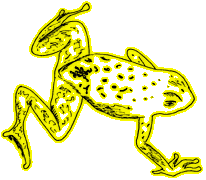| B r o m e l i a d F r o g
Two kinds of bromeliad frogs are marsupial frogs and the colorful poison arrow frogs. Some marsupial frogs carry their eggs and developing tadpoles under a skin flap on their back. When the female enters the water in the bromeliad pool, the tadpoles are released into the water and continue their development there. Poison arrow frogs. Brightly-colored and very poisonous poison arrow frogs (the source of the toxin Amazon Indians use to tip their poisoned blow darts) lay their eggs under wet leaves on the forest floor. The parents guard the eggs until they hatch, then carry the tadpoles on their backs, one at a time, high up into the canopy to a bromeliad pool. Only one tadpole is placed in each bromeliad pool, a behavior that scatters the tadpoles and reduces competition for limited food in the small pool. Predatory damselfly larvae also developing in the bromeliad pools are major predators of bromeliad frog tadpoles. The adult frogs, with their poison-laced skin, are protected from most predators. About 200 different poisonous chemicals have been found so far in the skin of these small frogs. (See LFRF Program 1 for a night-time frog hunt with Claude Gascon and listen for some amazing frog sounds!) |
![]()
 Many different kinds of small frogs live in and around the pools provided by the central cup of tank bromeliads. These frogs mainly eat ants and other small insects that come to the bromeliad. They
reproduce in the bromeliad, and their tadpoles develop in the water-filled pools, feeding off algae,
mosquito larvae, or other small organisms in the water.
Many different kinds of small frogs live in and around the pools provided by the central cup of tank bromeliads. These frogs mainly eat ants and other small insects that come to the bromeliad. They
reproduce in the bromeliad, and their tadpoles develop in the water-filled pools, feeding off algae,
mosquito larvae, or other small organisms in the water.